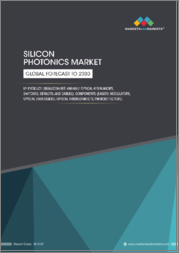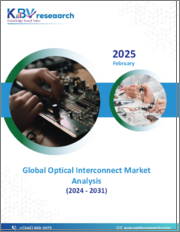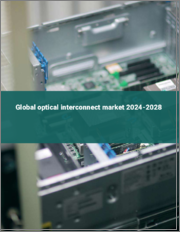
|
시장보고서
상품코드
1792263
광 상호연결 시장 보고서 : 제품 유형별, 상호연결 레벨별, 파이버 모드별, 용도별, 최종 이용 산업별, 지역별(2025-2033년)Optical Interconnect Market Report by Product Type, Interconnect Level, Fiber Mode, Application, End Use Industry, and Region 2025-2033 |
||||||
세계의 광 상호연결 시장 규모는 2024년 134억 달러에 달했습니다. IMARC Group은 2033년에는 343억 달러에 이를 전망이며, 2025-2033년 성장률(CAGR) 10.42%로 성장할 것으로 예측했습니다.
광 상호연결은 빛을 통해 여러 컴퓨터 시스템을 회로로 연결하는 데 사용되는 링크입니다. 네트워크 장비로부터 디지털 신호를 수신하고 광신호로 변환하여 파이버 네트워크로 전송하기 위한 인터페이스입니다. 광 상호연결은 고도의 신호 처리를 통해 광섬유의 오류 모니터링, 관리 및 왜곡 감소를 용이하게 합니다. 광 상호연결은 마더보드의 짧은 연결에서 대규모 네트워크에서 사용되는 수 킬로미터에 이르는 링크에 이르기까지 다양합니다. 이러한 상호연결은 주파수 의존 손실이 낮고 크로스 토크가 무시되고 대역폭이 넓기 때문에 반도체 산업에서 널리 사용됩니다.
가정, 상업 및 산업 분야에서 인터넷 서비스에 대한 수요가 증가하고 있는 것이 시장 성장을 가속하는 주요 요인이 되고 있습니다. 빅데이터 분석 및 사물인터넷(IoT) 도입에 따른 정보기술(IT) 분야의 급성장으로 고 데이터 전송 및 대역폭 통신 수요가 증가하고 있으며, 광 상호연결 수요가 세계적으로 높아지고 있습니다. 광 상호연결은 데이터 프로세서의 현재 성능 요구 사항을 충족시키기 위해 기존에 사용된 기술을 대체하는 보다 적절한 옵션으로 간주됩니다. 또한 데이터센터 네트워크의 전력 소비를 줄이면서 대역폭 확대에 대한 수요가 높아지고 있는 것도 성장을 가속하는 큰 요인이 되고 있습니다. 게다가 민간 부문 및 정부 부문 모두에서 네트워크 트래픽이 증가함에 따라 웹 애플리케이션 및 클라우드 컴퓨팅 시스템을 처리하면서 리소스를 효율적으로 활용하기 위한 광 상호연결 장치에 대한 수요가 증가하고 있습니다. 클라우드 애플리케이션이 신속한 커뮤니케이션을 촉진하고 디지털화의 동향이 높아짐에 따라 광 상호연결 시스템의 채용이 증가하고 있어 다양한 정보 중심 산업의 성장에 기여하고 있습니다.
이 보고서에서 다루는 주요 질문
- 세계의 광 상호연결 시장은 지금까지 어떻게 추이해 왔는가?
- 세계의 광 상호연결 업계의 주요 지역 시장은?
- 세계의 광 상호연결 업계에서 COVID-19의 영향은?
- 제품 유형별 시장 내역은?
- 상호연결 레벨별 시장 내역은?
- 파이버 모드별 시장 내역은?
- 용도별 시장 내역은?
- 최종 이용 산업별 시장 내역은?
- 세계 광 상호연결 산업의 밸류체인의 다양한 단계는?
- 세계의 광 상호연결 산업에서 주요 촉진요인 및 과제는 무엇인가?
- 세계 광 상호연결 산업의 구조 및 주요 기업은?
목차
제1장 서문
제2장 조사 범위 및 조사 방법
- 조사의 목적
- 이해관계자
- 데이터 소스
- 1차 정보
- 2차 정보
- 시장 추정
- 상향식 접근
- 하향식 접근
- 조사 방법
제3장 주요 요약
제4장 서문
- 개요
- 주요 업계 동향
제5장 세계의 광 상호연결 시장
- 시장 개요
- 시장 실적
- COVID-19의 영향
- 시장 내역 : 제품 유형별
- 시장 내역 : 상호 접속 레벨별
- 시장 내역 : 파이버 모드별
- 시장 내역 : 용도별
- 시장 내역 : 최종 이용 산업별
- 시장 내역 : 지역별
- 시장 예측
제6장 시장 내역 : 제품 유형별
- 케이블 어셈블리
- 시장 내역 : 유형별
- 실내 케이블 어셈블리
- 옥외 케이블 어셈블리
- 액티브 광케이블
- 멀티 소스 계약
- 주요 유형
- QSFP
- CXP
- CFP
- CDFP
- 주요 유형
- 시장 예측
- 시장 내역 : 유형별
- 커넥터
- 시장 동향
- 주요 유형
- LC 커넥터
- SC 커넥터
- ST 커넥터
- MPO/MTP 커넥터
- 시장 예측
- 광 트랜시버
- 시장 동향
- 시장 예측
- 자유 공간 광통신, 광섬유, 도파로
- 시장 동향
- 시장 예측
- 실리콘 포토닉스
- 시장 동향
- 시장 예측
- PIC 기반 상호 연결
- 시장 동향
- 시장 예측
- 광 엔진
- 시장 동향
- 시장 예측
제7장 시장 내역 : 상호연결 레벨별
- 칩 레벨 및 보드 레벨 상호연결
- 보드 간 및 랙 레벨 광 상호연결
- 메트로 및 장거리 광 상호연결
제8장 시장 내역 : 파이버 모드별
- 멀티 모드 파이버
- 주요 유형
- 스텝 인덱스 멀티 모드 파이버
- 그레이디드 인덱스 멀티 모드 파이버
- 주요 유형
- 싱글 모드 파이버
제9장 시장 내역 : 용도별
- 데이터 통신
- 주요 유형
- 데이터센터
- 고성능 컴퓨팅(HPC)
- 주요 유형
- 통신
제10장 시장 내역 : 최종 이용 산업별
- 군사 및 항공우주
- 가전
- 자동차
- 화학약품
- 기타
제11장 시장 내역 : 지역별
- 북미
- 유럽
- 아시아태평양
- 중동 및 아프리카
- 라틴아메리카
제12장 SWOT 분석
- 개요
- 강점
- 약점
- 기회
- 위협
제13장 밸류체인 분석
제14장 Porter's Five Forces 분석
- 개요
- 구매자의 협상력
- 공급기업의 협상력
- 경쟁도
- 신규 참가업체의 위협
- 대체품의 위협
제15장 가격 분석
제16장 경쟁 구도
- 시장 구조
- 주요 기업
- 주요 기업 프로파일
- Finisar
- Mellanox Technologies
- Molex
- Oclaro
- Sumitomo Electric Industries
- Broadcom
- TE Connectivity
- Amphenol
- Juniper Networks
- Fujitsu
- Infinera Corporation
- Lumentum Holdings
- OFS Fitel, LLC(FURUKAWA ELECTRIC CO., LTD)
- 3M Company
- Acacia Communication
- Dow Corning
- Huawei
- Intel
- Infineon Technologies
The global optical interconnect market size reached USD 13.4 Billion in 2024. Looking forward, IMARC Group expects the market to reach USD 34.3 Billion by 2033, exhibiting a growth rate (CAGR) of 10.42% during 2025-2033.
An optical interconnect is a link that is used to connect multiple computer systems in a circuit through light. It is an interface that assists in receiving digital signals from network equipment and converting them into optical signals that are transmitted through the fiber network. Advanced signal processing is facilitated by optical interconnect to monitor or manage errors and reduce distortion in fiber optics. Optical interconnections can range from short connections on motherboards to kilometer-long links used in large area networks. These interconnects have a low frequency-dependent loss, negligible crosstalk and high bandwidth due to which they find wide applications in the semiconductor industry.
Increasing demand for internet services across the domestic, commercial and industrial sectors is the key factor driving the market growth. Owing to the rapid growth of the information technology (IT) sector along with the introduction of big data analytics and Internet of Things (IoT), the demand for high data transmission and bandwidth communication is on the rise, which has led to an increased demand for optical interconnect globally. Optical interconnect is considered a more suitable alternative to the traditionally used technologies, in order to meet the current performance requirements of data processors. Also, the rising demand for increased bandwidth capacity along with the reduced power consumption within data center networks is acting as a major growth-inducing factor. Furthermore, rising network traffic from both private and government sectors has resulted in an increasing demand for optical interconnect devices for efficient utilization of resources while handling web applications and cloud computing systems. With cloud applications facilitating rapid communication and the rising trend of digitalization, there is a rise in the adoption of optical interconnect systems that favor the growth of various information-centric industries.
Key Market Segmentation:
Breakup by Product Type:
- Cable Assemblies
- Indoor Cable Assemblies
- Outdoor Cable Assemblies
- Active Optical Cables
- Multi-Source Agreement
- QSFP
- CXP
- CFP
- CDFP
- Connectors
- LC Connectors
- SC Connectors
- ST Connectors
- MPO/MTP Connectors
- Optical Transceivers
- Free Space Optics, Fiber and Waveguides
- Silicon Photonics
- PIC-Based Interconnects
- Optical Engines
Breakup by Interconnect Level:
- Chip- & Board-Level Interconnect
- Board-To-Board and Rack-Level Optical Interconnect
- Metro & Long Haul Optical Interconnect
Breakup by Fiber Mode:
- Multi-Mode Fiber
- Step Index Multi-Mode Fiber
- Graded Index Multi-Mode Fiber
- Single-Mode Fiber
Breakup by Application:
- Data Communication
- Data Center
- High-Performance Computing (HPC)
- Telecommunication
Breakup by End Use Industry:
- Military and Aerospace
- Consumer Electronics
- Automotive
- Chemicals
- Others
Breakup by Region:
- North America
- Europe
- Asia Pacific
- Middle East and Africa
- Latin America
Competitive Landscape:
The report has also analysed the competitive landscape of the market with some of the key players being Finisar, Mellanox Technologies, Molex, Oclaro, Sumitomo Electric Industries, Broadcom, TE Connectivity, Amphenol, Juniper Networks, Fujitsu, Infinera Corporation, Lumentum Holdings, OFS Fitel, LLC (FURUKAWA ELECTRIC CO., LTD), 3M Company, Acacia Communication, Dow Corning, Huawei, Intel, Infineon Technologies, etc.
Key Questions Answered in This Report:
- How has the global optical interconnect market performed so far and how will it perform in the coming years?
- What are the key regional markets in the global optical interconnect industry?
- What has been the impact of COVID-19 on the global optical interconnect industry?
- What is the breakup of the market based on the product type?
- What is the breakup of the market based on the interconnect level?
- What is the breakup of the market based on the fiber mode?
- What is the breakup of the market based on the application?
- What is the breakup of the market based on the end use industry?
- What are the various stages in the value chain of the global optical interconnect industry?
- What are the key driving factors and challenges in the global optical interconnect industry?
- What is the structure of the global optical interconnect industry and who are the key players?
Table of Contents
1 Preface
2 Scope and Methodology
- 2.1 Objectives of the Study
- 2.2 Stakeholders
- 2.3 Data Sources
- 2.3.1 Primary Sources
- 2.3.2 Secondary Sources
- 2.4 Market Estimation
- 2.4.1 Bottom-Up Approach
- 2.4.2 Top-Down Approach
- 2.5 Forecasting Methodology
3 Executive Summary
4 Introduction
- 4.1 Overview
- 4.2 Key Industry Trends
5 Global Optical Interconnect Market
- 5.1 Market Overview
- 5.2 Market Performance
- 5.3 Impact of COVID-19
- 5.4 Market Breakup by Product Type
- 5.5 Market Breakup by Interconnect Level
- 5.6 Market Breakup by Fiber Mode
- 5.7 Market Breakup by Application
- 5.8 Market Breakup by End Use Industry
- 5.9 Market Breakup by Region
- 5.10 Market Forecast
6 Market Breakup by Product Type
- 6.1 Cable Assemblies
- 6.1.1 Market Trends
- 6.1.2 Market Breakup by Type
- 6.1.2.1 Indoor Cable Assemblies
- 6.1.2.2 Outdoor Cable Assemblies
- 6.1.2.3 Active Optical Cables
- 6.1.2.4 Multi-Source Agreement
- 6.1.2.4.1 Market Trends
- 6.1.2.4.2 Major Types
- 6.1.2.4.2.1 QSFP
- 6.1.2.4.2.2 CXP
- 6.1.2.4.2.3 CFP
- 6.1.2.4.2.4 CDFP
- 6.1.2.4.3 Market Forecast
- 6.1.3 Market Forecast
- 6.2 Connectors
- 6.2.1 Market Trends
- 6.2.2 Major Types
- 6.2.2.1 LC Connectors
- 6.2.2.2 SC Connectors
- 6.2.2.3 ST Connectors
- 6.2.2.4 MPO/MTP Connectors
- 6.2.3 Market Forecast
- 6.3 Optical Transceivers
- 6.3.1 Market Trends
- 6.3.2 Market Forecast
- 6.4 Free Space Optics, Fiber and Waveguides
- 6.4.1 Market Trends
- 6.4.2 Market Forecast
- 6.5 Silicon Photonics
- 6.5.1 Market Trends
- 6.5.2 Market Forecast
- 6.6 PIC-Based Interconnects
- 6.6.1 Market Trends
- 6.6.2 Market Forecast
- 6.7 Optical Engines
- 6.7.1 Market Trends
- 6.7.2 Market Forecast
7 Market Breakup by Interconnect Level
- 7.1 Chip- & Board-Level Interconnect
- 7.1.1 Market Trends
- 7.1.2 Market Forecast
- 7.2 Board-To-Board and Rack-Level Optical Interconnect
- 7.2.1 Market Trends
- 7.2.2 Market Forecast
- 7.3 Metro & Long Haul Optical Interconnect
- 7.3.1 Market Trends
- 7.3.2 Market Forecast
8 Market Breakup by Fiber Mode
- 8.1 Multi-Mode Fiber
- 8.1.1 Market Trends
- 8.1.2 Major Types
- 8.1.2.1 Step Index Multi-Mode Fiber
- 8.1.2.2 Graded Index Multi-Mode Fiber
- 8.1.3 Market Forecast
- 8.2 Single-Mode Fiber
- 8.2.1 Market Trends
- 8.2.2 Market Forecast
9 Market Breakup by Application
- 9.1 Data Communication
- 9.1.1 Market Trends
- 9.1.2 Major Types
- 9.1.2.1 Data Center
- 9.1.2.2 High-Performance Computing (HPC)
- 9.1.3 Market Forecast
- 9.2 Telecommunication
- 9.2.1 Market Trends
- 9.2.2 Market Forecast
10 Market Breakup by End Use Industry
- 10.1 Military and Aerospace
- 10.1.1 Market Trends
- 10.1.2 Market Forecast
- 10.2 Consumer Electronics
- 10.2.1 Market Trends
- 10.2.2 Market Forecast
- 10.3 Automotive
- 10.3.1 Market Trends
- 10.3.2 Market Forecast
- 10.4 Chemicals
- 10.4.1 Market Trends
- 10.4.2 Market Forecast
- 10.5 Others
- 10.5.1 Market Trends
- 10.5.2 Market Forecast
11 Market Breakup by Region
- 11.1 North America
- 11.1.1 Market Trends
- 11.1.2 Market Forecast
- 11.2 Europe
- 11.2.1 Market Trends
- 11.2.2 Market Forecast
- 11.3 Asia Pacific
- 11.3.1 Market Trends
- 11.3.2 Market Forecast
- 11.4 Middle East and Africa
- 11.4.1 Market Trends
- 11.4.2 Market Forecast
- 11.5 Latin America
- 11.5.1 Market Trends
- 11.5.2 Market Forecast
12 SWOT Analysis
- 12.1 Overview
- 12.2 Strengths
- 12.3 Weaknesses
- 12.4 Opportunities
- 12.5 Threats
13 Value Chain Analysis
14 Porter's Five Forces Analysis
- 14.1 Overview
- 14.2 Bargaining Power of Buyers
- 14.3 Bargaining Power of Suppliers
- 14.4 Degree of Competition
- 14.5 Threat of New Entrants
- 14.6 Threat of Substitutes
15 Price Analysis
16 Competitive Landscape
- 16.1 Market Structure
- 16.2 Key Players
- 16.3 Profiles of Key Players
- 16.3.1 Finisar
- 16.3.2 Mellanox Technologies
- 16.3.3 Molex
- 16.3.4 Oclaro
- 16.3.5 Sumitomo Electric Industries
- 16.3.6 Broadcom
- 16.3.7 TE Connectivity
- 16.3.8 Amphenol
- 16.3.9 Juniper Networks
- 16.3.10 Fujitsu
- 16.3.11 Infinera Corporation
- 16.3.12 Lumentum Holdings
- 16.3.13 OFS Fitel, LLC (FURUKAWA ELECTRIC CO., LTD)
- 16.3.14 3M Company
- 16.3.15 Acacia Communication
- 16.3.16 Dow Corning
- 16.3.17 Huawei
- 16.3.18 Intel
- 16.3.19 Infineon Technologies


















